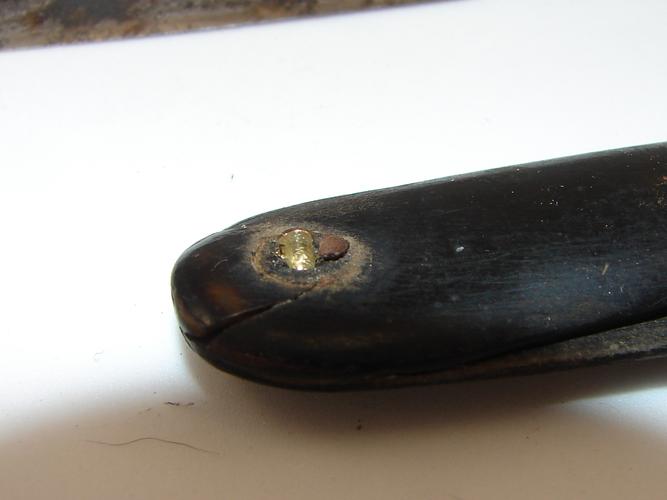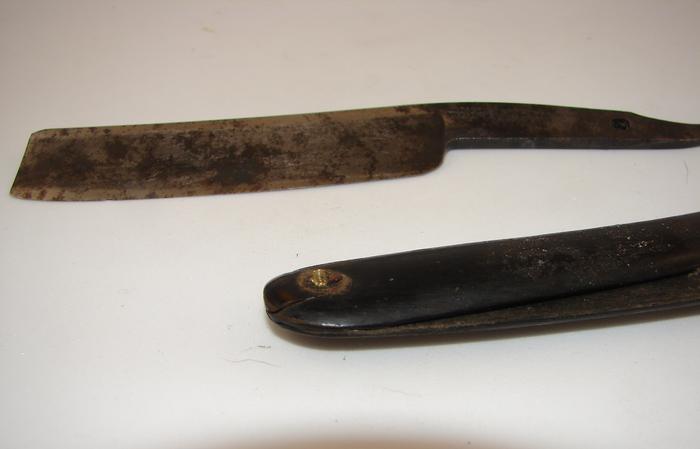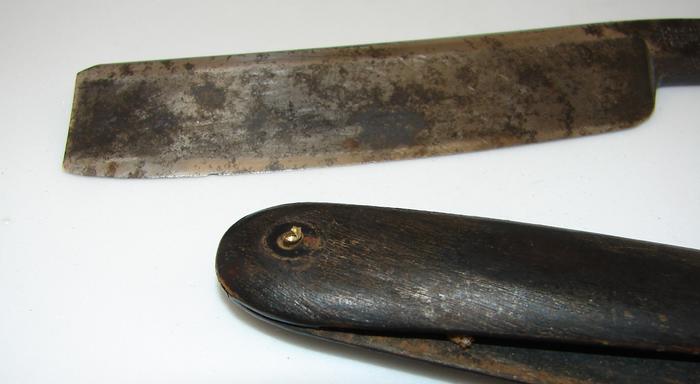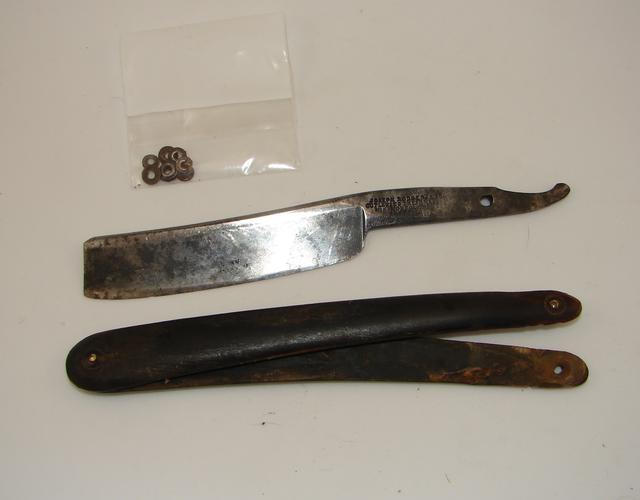Results 1 to 10 of 12
Thread: Double pin on wedge end of scale
-
08-08-2014, 03:24 AM #1
 Double pin on wedge end of scale
Double pin on wedge end of scale
Recently picked up a Joseph Rodgers & Sons 5/8 near wedge in horn scales. While the razor was a good price and the blade can be restored I was after the mushroom/upside down cup..... (whatever you call it) washers. Upon unpinning using the drill press method (http://straightrazorpalace.com/works...-out-pins.html great info from mycarver, gssixgun, pixelfixed, and sharptonn) it found that the wedge end had a double pin. I remember someone (gssixgun?) had posted something about that once upon a time and thought I might share. Scales are black horn with an integrated wedge.




The domed washer covered it very well and I did not detect any obvious signs of a re-pin The older I get the more I realize how little I actually know.
The older I get the more I realize how little I actually know.
-
08-08-2014, 03:26 AM #2

I am going to be keeping an eye on this one to see what the explanation is. I figure that it was a repair to take up slack in the pivot
 SRP. Where the Wits aren't always as sharp as the Razors
SRP. Where the Wits aren't always as sharp as the Razors
http://straightrazorplace.com/shaving-straight-razor/111719-i-hate-you-all.html
-
08-08-2014, 03:43 AM #3

I was thinking that or the horn quality wasn't up to snuff or was shaped poorly? Maybe was only way to get wedge end to meet up. Or it could of just been a marketing gimmick.
"Good sir, are you tired of your razors falling apart after only 20 years of use? Try the new and improved double pinned wedge! Because if one pin is good, surely two is better!"The older I get the more I realize how little I actually know.
-
08-08-2014, 03:57 AM #4

Or it could be a Francis Bacon kind of thing, "two pin of not to pin, that is the question..."
SRP. Where the Wits aren't always as sharp as the Razors
http://straightrazorplace.com/shaving-straight-razor/111719-i-hate-you-all.html
-
08-08-2014, 02:52 PM #5Senior Member



- Join Date
- Apr 2012
- Location
- Diamond Bar, CA
- Posts
- 6,553
Thanked: 3215
I’ve done that temporally, with a loose battery cable terminal, with a drywall screw.
Actually, worked well, until I replaced the battery.
-
08-08-2014, 03:41 PM #6Senior Member



- Join Date
- Apr 2008
- Location
- Essex, UK
- Posts
- 3,816
Thanked: 3164
I have seen it a number of times, but all on early 19th century razors - under the large bulls-eye washer you sometimes find a pin set off to one side, very thin, usually iron. The type of scale I have seen it on didn't normally have a separate wedge.
I did save a number of these old scales that I had replaced intending to photograph them, but they disappeared for a long while before turning up in the washing machine. Hot water certainly curls-up horn nicely.
It is so frequent that I think the scales were pinned together in sets this way for some reason. Maybe it was to help keep them together while they were worked to shape - they did not have double-sided tape back then. I doubt that we will ever know the answer - they didn't tend to write down everything back then - I guess they were either to busy, thought too little of it or they couldn't write in the first place.
I would assume that the scale making part of things was a separate profession, and that little mesters bought in scales rather than made them. That might help explain things a bit. Later on you find the scale-pressers initials set in the back face of the scale from having been set or scratched in the iron mould. Might have some correlation, might not. Who knows?
Regards,
NeilLast edited by Neil Miller; 08-08-2014 at 03:48 PM.
-
-
08-08-2014, 04:41 PM #7

Many times it is done to stabilize the wedge end after damage/crack. The crack above looks away from the pivot, however.
This (below) was done as a repair! What bugs me about the "being done as it was made" theory is the pin is brass and the second one is iron. In 'aftermarket' repairs, not everyone had brass rod around, but nails were easy to come by!"Don't be stubborn. You are missing out."
I rest my case.
-
08-08-2014, 07:21 PM #8

I've been guilty of using double pins on a few things over years. My reason, and possibly theirs, was to hold the pin locked in place while I peened the head down to the washer. If your workbench is made of wood without an anvil or vise or something metal to hold the far side of pin, then a small nail holds the pin while you peen it.
Some people never go crazy. What truly horrible lives they must lead - Charles Bukowski
-
08-09-2014, 12:26 AM #9Senior Member



- Join Date
- Apr 2008
- Location
- Essex, UK
- Posts
- 3,816
Thanked: 3164
The examples I am thinking of were not cracked or broken in any way at all. They were part of a process, not a shoddy, highly visible repair.
The main pins were steel and the smaller diameter pin was steel rod, not a tack.
The scales had the original main pins untampered with, with the thinner rod right next to them, completely hidden under the original washer.
There is absolutely no way that these were repair jods, They were clearly that way before the main pinning was done.
Those guys did not deal with making or tinkering with a single razor - they made many every day, for all their working lives, and the setters-in who placed those blades in scales possibly worked for more than one cutler, so saw many more jobs pass through their hands.
It is obvious to me that the secondary pinnings, the hidden ones in unbroken scales that I have seen, were period and done for a good reason. Just because we do not know what that reason was is more to do with us being tinkerers than time-served apprentices, journey men and cutlers - a process which was full time and lasted 7 or 8 years.
Regards,
Neil
-
The Following User Says Thank You to Neil Miller For This Useful Post:
sharptonn (08-09-2014)
-
08-09-2014, 01:05 AM #10

Good point, Neil. I wonder if it was done to keep the scales solid as they were finished at the bottom. To keep the wedge from moving and breakage from occurring during transport from the scalemaker's shop to the location of where the blades were pinned in?
Seems it would cut down on problems on the other end, so to speak!"Don't be stubborn. You are missing out."
I rest my case.


 15Likes
15Likes LinkBack URL
LinkBack URL About LinkBacks
About LinkBacks







 Reply With Quote
Reply With Quote